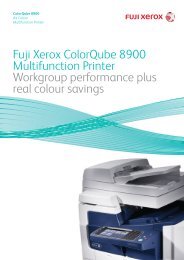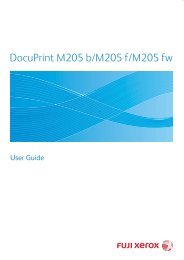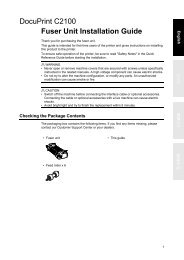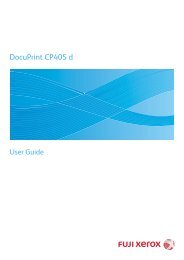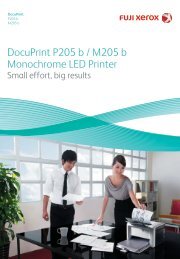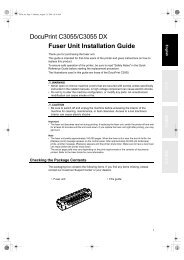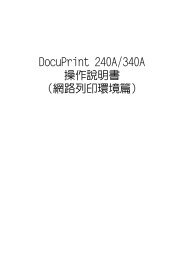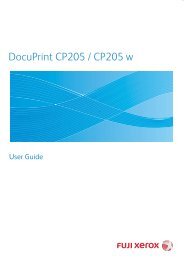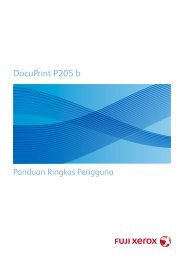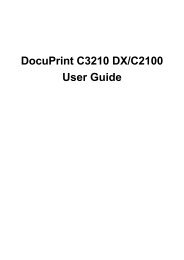Download - Xerox Support and Drivers
Download - Xerox Support and Drivers
Download - Xerox Support and Drivers
Create successful ePaper yourself
Turn your PDF publications into a flip-book with our unique Google optimized e-Paper software.
Media typeGuidelinesMedia typeGuidelinesTransparenciesLabelsCard stock orcustom-sizedmaterials• To avoid damaging the printer, use onlytransparencies designed for use in laser printers.• Transparencies used in the printer must be ableto withst<strong>and</strong> 200° C (392° F), the printer’s fusingtemperature.• Place them on a flat surface after removing themfrom the printer.• Do not leave them in the paper tray for longperiods of time. Dust <strong>and</strong> dirt may accumulateon them, resulting in spotty printing.• To avoid smudging caused by fingerprints,h<strong>and</strong>le them carefully.• To avoid fading, do not expose printedtransparencies to prolonged sunlight.• Ensure that transparencies are not wrinkled,curled, or have any torn edges.• To avoid damaging the printer, use only labelsdesigned for use in laser printers.• When selecting labels, consider the followingfactors:- Adhesives: The adhesive material should bestable at 200° C (392° F), the printer’s fusingtemperature.- Arrangement: Only use labels with no exposedbacking between them. Labels can peel offsheets that have spaces between the labels,causing serious jams.- Curl: Prior to printing, labels must lie flat withno more than 13 mm (5 inches) of curl in anydirection.- Condition: Do not use labels with wrinkles,bubbles, or other indications of separation.• Make sure that there is no exposed adhesivematerial between labels. Exposed areas cancause labels to peel off during printing, whichcan cause paper jams. Exposed adhesive canalso cause damage to printer components.• Do not run a sheet of labels through the printermore than once. The adhesive backing isdesigned for only a single pass through theprinter.• Do not use labels that are separating from thebacking sheet or are wrinkled, bubbled, orotherwise damaged.• Do not print on media smaller than 76 mm(3 inches) wide or 127 mm (5 inches) long.• In the software application, set margins at least6.4 mm (0.25 inches) away from the edges ofthe material.Preprintedpaper• Letterhead must be printed with heat-resistantink that will not melt, vaporize, or releasehazardous emissions when subjected to theprinter’s fusing temperature of 200° C (392° F)for 0.1 second.• Letterhead ink must be non-flammable <strong>and</strong>should not adversely affect printer rollers.• Forms <strong>and</strong> letterhead should be sealed in amoisture-proof wrapping to prevent changesduring storage.• Before you load preprinted paper, such as forms<strong>and</strong> letterhead, verify that the ink on the paper isdry. During the fusing process, wet ink can comeoff preprinted paper, reducing print quality.Loading paperLoad the print media you use for the majority of your print jobs in the tray 1.The tray 1 can hold a maximum of 250 sheets of 75 g/m 2 (20 lb) plainpaper.You can purchase an optional tray (tray 2) <strong>and</strong> attach it below thest<strong>and</strong>ard tray to load an additional 250 sheets of paper. For orderinformation for an optional tray, see page 7.1.The paper level indicator on the front of the tray 1 <strong>and</strong> the optional tray 2shows the amount of paper currently left in the tray. When the tray is empty,the indicator of the bar is completely lowered.Full ▲▲ Empty5.4




